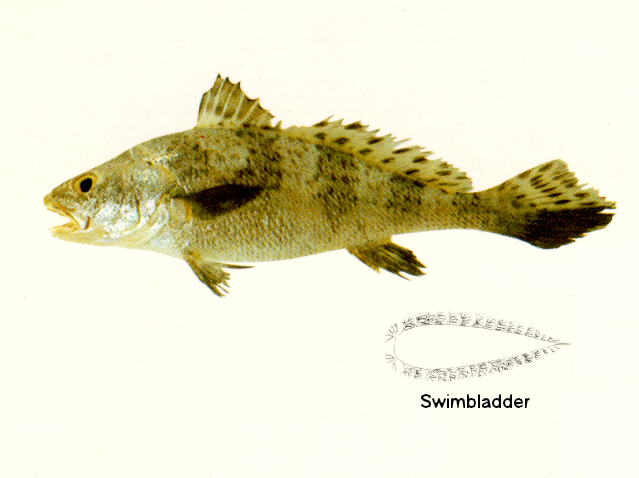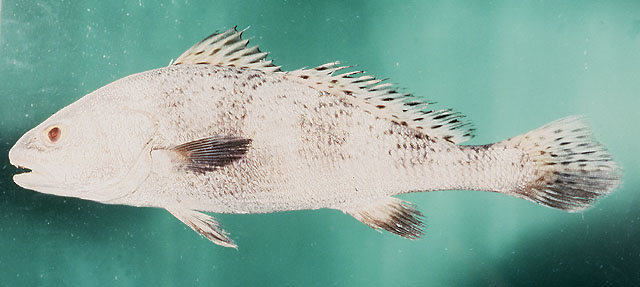Protonibea
diacanthus
(Lacepède,
1802)
Blackspotted croaker
View all media / Upload your photos and videos
Expand all
Classification / Names
Teleostei (teleosts) > Eupercaria/misc (Various families in series Eupercaria) >
Sciaenidae (Drums or croakers)
Etymology: Protonibea: Greek, protos = the first + see under Nibea
More on author:
Lacepède.
Environment / milieu / depth range / climate zone / distribution range
Marine; brackish; demersal; depth range 5 - 100 m (Ref. 43239); tropical; 40°N - 28°S47°E - 154°E.
Distribution
Indo-West Pacific: west coast of the Persian Gulf and along the coasts of India and Sri Lanka, north to Japan and south through the Philippines and Borneo to New Guinea and northern Australia.
Maps

Protonibea diacanthus / Native range
AquaMaps Data sources:
GBIF
OBIS
This map was computer-generated and has not yet been reviewed.

Protonibea diacanthus / Suitable habitat
AquaMaps Data sources:
GBIF
OBIS
This map was computer-generated and has not yet been reviewed.

Protonibea diacanthus / Point map
AquaMaps Data sources:
GBIF
OBIS
This map was computer-generated and has not yet been reviewed.

Protonibea diacanthus / Year 2050
AquaMaps Data sources:
GBIF
OBIS
This map was computer-generated and has not yet been reviewed.
Length at first maturity / Size / Weight / Age
Short description
Biology
Found in coastal waters over muddy bottoms, off the sea-bed. Ascend tidal rivers and estuaries (Ref. 9772). Feed mainly on crustaceans and small fishes. Also caught with bottom trawls (Ref. 9772). Sold fresh and dried salted (swim bladder) in markets. An important food fish. Minimum depth range based on occurrence (Ref. 118911).
Main reference
Lal Mohan, R.S. 1984 Sciaenidae. In W. Fischer and G. Bianchi (eds.) FAO species identification sheets for fishery purposes. Western Indian Ocean (Fishing Area 51). Vol. 4. FAO, Rome. pag. var. (Ref. 3490)
IUCN Red List Status (Ref. 125652)
Near Threatened (NT), A2b; date assessed: July 30 2018
CITES (Ref. 131153)
Not Evaluated
CMS (Ref. 116361)
Not Evaluated
Threat to humans
Harmless
More information
- Countries
- FAO areas
- Ecosystems
- Occurrences
- Introductions
- Stocks
- Ecology
- Diet
- Food items
- Food consumption
- Ration
- Common names
- Synonyms
- Metabolism
- Predators
- Ecotoxicology
- Reproduction
- Maturity
- Spawning
- Spawning aggregation
- Fecundity
- Eggs
- Egg development
- Age/Size
- Growth
- Length-weight
- Length-length
- Length-frequencies
- Morphometrics
- Morphology
- Larvae
- Larval dynamics
- Recruitment
- Abundance
- References
- Aquaculture
- Aquaculture profile
- Strains
- Genetics
- Allele frequencies
- Heritability
- Diseases
- Processing
- Mass conversion
- Vision
- Pictures
- Stamps, Coins Misc.
- Sounds
- Ciguatera
- Speed
- Swim. type
- Gill area
- Otoliths
- Brains
Estimates based on models
Preferred temperature (Ref. 123201): 24.6 - 29.1, mean 28.2 °C (based on 1838 cells).
Phylogenetic diversity index (Ref. 82804): PD50 = 1 [Uniqueness, from 0.5 = low to 2.0 = high].
Bayesian length-weight: a=0.00813 (0.00538 - 0.01228), b=3.07 (2.95 - 3.19), in cm total length, based on LWR estimates for this species & (Sub)family-body (Ref. 93245).
Trophic level (Ref. 69278): 3.5 ±0.6 se; Based on diet studies.
Resilience (Ref. 120179): Medium, minimum population doubling time 1.4 - 4.4 years (K=0.29-0.52; tmax=8).
Fishing vulnerability (Ref. 59153): Moderate vulnerability (45 of 100).
Price category (Ref. 80766): Medium; Very questionable: based on ex-vessel price for species in this family.
Nutrients (Ref. 124155): Calcium = 40.5 [14.2, 156.2] mg/100g; Iron = 0.578 [0.238, 1.642] mg/100g; Protein = 19.1 [17.3, 21.0] %; Omega3 = 0.206 [0.112, 0.346] g/100g; Selenium = 84.9 [44.5, 168.2] μg/100g; VitaminA = 9.38 [2.40, 34.23] μg/100g; Zinc = 0.722 [0.405, 1.471] mg/100g (wet weight); based on nutrient studies.








